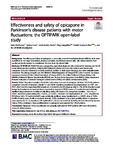Effectiveness and safety of opicapone in Parkinson’s disease patients with motor fluctuations: the OPTIPARK open-label study
| dc.contributor.author | Reichmann, H | |
| dc.contributor.author | Lees, A | |
| dc.contributor.author | Rocha, J-F | |
| dc.contributor.author | Magalhães, D | |
| dc.contributor.author | Soares-da-Silva, P | |
| dc.date.accessioned | 2020-03-23T13:00:36Z | |
| dc.date.available | 2020-03-23T13:00:36Z | |
| dc.date.issued | 2020-12 | |
| dc.identifier.issn | 2047-9158 | |
| dc.identifier.issn | 2047-9158 | |
| dc.identifier.other | 9 | |
| dc.identifier.uri | http://hdl.handle.net/10026.1/15468 | |
| dc.description.abstract |
<jats:title>Abstract</jats:title><jats:sec> <jats:title>Background</jats:title> <jats:p>The efficacy and safety of opicapone, a once-daily catechol-O-methyltransferase inhibitor, have been established in two large randomized, placebo-controlled, multinational pivotal trials. Still, clinical evidence from routine practice is needed to complement the data from the pivotal trials.</jats:p> </jats:sec><jats:sec> <jats:title>Methods</jats:title> <jats:p>OPTIPARK (NCT02847442) was a prospective, open-label, single-arm trial conducted in Germany and the UK under clinical practice conditions. Patients with Parkinson’s disease and motor fluctuations were treated with opicapone 50 mg for 3 (Germany) or 6 (UK) months in addition to their current levodopa and other antiparkinsonian treatments. The primary endpoint was the Clinician’s Global Impression of Change (CGI-C) after 3 months. Secondary assessments included Patient Global Impressions of Change (PGI-C), the Unified Parkinson’s Disease Rating Scale (UPDRS), Parkinson’s Disease Questionnaire (PDQ-8), and the Non-Motor Symptoms Scale (NMSS). Safety assessments included evaluation of treatment-emergent adverse events (TEAEs) and serious adverse events (SAEs).</jats:p> </jats:sec><jats:sec> <jats:title>Results</jats:title> <jats:p>Of the 506 patients enrolled, 495 (97.8%) took at least one dose of opicapone. Of these, 393 (79.4%) patients completed 3 months of treatment. Overall, 71.3 and 76.9% of patients experienced any improvement on CGI-C and PGI-C after 3 months, respectively (full analysis set). At 6 months, for UK subgroup only (<jats:italic>n</jats:italic> = 95), 85.3% of patients were judged by investigators as improved since commencing treatment. UPDRS scores at 3 months showed statistically significant improvements in activities of daily living during OFF (mean ± SD change from baseline: − 3.0 ± 4.6, <jats:italic>p</jats:italic> < 0.0001) and motor scores during ON (− 4.6 ± 8.1, <jats:italic>p</jats:italic> < 0.0001). The mean ± SD improvements of − 3.4 ± 12.8 points for PDQ-8 and -6.8 ± 19.7 points for NMSS were statistically significant versus baseline (both <jats:italic>p</jats:italic> < 0.0001). Most of TEAEs (94.8% of events) were of mild or moderate intensity. TEAEs considered to be at least possibly related to opicapone were reported for 45.1% of patients, with dyskinesia (11.5%) and dry mouth (6.5%) being the most frequently reported. Serious TEAEs considered at least possibly related to opicapone were reported for 1.4% of patients.</jats:p> </jats:sec><jats:sec> <jats:title>Conclusions</jats:title> <jats:p>Opicapone 50 mg was effective and generally well-tolerated in PD patients with motor fluctuations treated in clinical practice.</jats:p> </jats:sec><jats:sec> <jats:title>Trial registration</jats:title> <jats:p>Registered in July 2016 at clinicaltrials.gov (<jats:ext-link xmlns:xlink="http://www.w3.org/1999/xlink" ext-link-type="uri" xlink:href="https://clinicaltrials.gov/ct2/show/study/NCT02847442">NCT02847442</jats:ext-link>).</jats:p> </jats:sec> | |
| dc.format.extent | 9- | |
| dc.format.medium | Electronic | |
| dc.language | en | |
| dc.language.iso | en | |
| dc.publisher | Springer Science and Business Media LLC | |
| dc.subject | Levodopa | |
| dc.subject | Motor fluctuations | |
| dc.subject | Open-label | |
| dc.subject | Opicapone | |
| dc.subject | Parkinson's disease | |
| dc.title | Effectiveness and safety of opicapone in Parkinson’s disease patients with motor fluctuations: the OPTIPARK open-label study | |
| dc.type | journal-article | |
| dc.type | Clinical Trial | |
| dc.type | Journal Article | |
| dc.type | Multicenter Study | |
| dc.type | Research Support, Non-U.S. Gov't | |
| plymouth.author-url | https://www.webofscience.com/api/gateway?GWVersion=2&SrcApp=PARTNER_APP&SrcAuth=LinksAMR&KeyUT=WOS:000520444400001&DestLinkType=FullRecord&DestApp=ALL_WOS&UsrCustomerID=11bb513d99f797142bcfeffcc58ea008 | |
| plymouth.issue | 1 | |
| plymouth.volume | 9 | |
| plymouth.publication-status | Published | |
| plymouth.journal | Translational Neurodegeneration | |
| dc.identifier.doi | 10.1186/s40035-020-00187-1 | |
| plymouth.organisational-group | /Plymouth | |
| plymouth.organisational-group | /Plymouth/Faculty of Health | |
| plymouth.organisational-group | /Plymouth/Faculty of Health/Peninsula Medical School | |
| plymouth.organisational-group | /Plymouth/REF 2021 Researchers by UoA | |
| plymouth.organisational-group | /Plymouth/REF 2021 Researchers by UoA/UoA03 Allied Health Professions, Dentistry, Nursing and Pharmacy | |
| plymouth.organisational-group | /Plymouth/Research Groups | |
| plymouth.organisational-group | /Plymouth/Research Groups/FoH - Applied Parkinson's Research | |
| plymouth.organisational-group | /Plymouth/Research Groups/FoH - Community and Primary Care | |
| plymouth.organisational-group | /Plymouth/Research Groups/Institute of Translational and Stratified Medicine (ITSMED) | |
| plymouth.organisational-group | /Plymouth/Research Groups/Institute of Translational and Stratified Medicine (ITSMED)/CCT&PS | |
| plymouth.organisational-group | /Plymouth/Research Groups/Plymouth Institute of Health and Care Research (PIHR) | |
| plymouth.organisational-group | /Plymouth/Users by role | |
| plymouth.organisational-group | /Plymouth/Users by role/Academics | |
| dc.publisher.place | England | |
| dcterms.dateAccepted | 2020-02-17 | |
| dc.rights.embargodate | 2020-6-6 | |
| dc.identifier.eissn | 2047-9158 | |
| dc.rights.embargoperiod | Not known | |
| rioxxterms.versionofrecord | 10.1186/s40035-020-00187-1 | |
| rioxxterms.licenseref.uri | http://www.rioxx.net/licenses/all-rights-reserved | |
| rioxxterms.licenseref.startdate | 2020-12 | |
| rioxxterms.type | Journal Article/Review |


